Understanding Pet Incinerator Cost: A Complete Breakdown
The average pet incinerator cost ranges from $21,700 for small units to $220,000 for full-scale commercial systems, with installation adding $3,000-$50,000 depending on complexity.
| Pet Incinerator Size | Equipment Cost | Daily Capacity | Est. Annual Profit |
|---|---|---|---|
| Small (clinic-sized) | $21,700 | 1-7 pets | $20,332 |
| Medium | $55,000 | 15-30 pets | $32,760 |
| Large/Commercial | $170,000-$220,000 | 60+ pets | $176,840 |
| Additional costs: Installation ($3K-$50K), Permits ($5K-$15K), Operating costs (~$58/cremation) |
Investing in pet cremation equipment represents a significant but potentially profitable decision for veterinary clinics and pet memorial businesses. The total pet incinerator cost involves more than just the purchase price—it includes installation, permits, ongoing fuel consumption, maintenance, and labor costs that all factor into your long-term return on investment.
When evaluating different systems, you'll need to consider both upfront expenses and operational efficiency. High-quality units with proper refractory lining and dual-chamber technology may cost more initially but often deliver substantial savings through reduced fuel consumption—some manufacturers claim up to 40% greater efficiency than competitors.
I'm Mortuary Cooler, a national supplier of mortuary equipment with extensive experience helping funeral homes and veterinary facilities steer pet incinerator cost considerations and select equipment that balances initial investment with long-term operational efficiency.
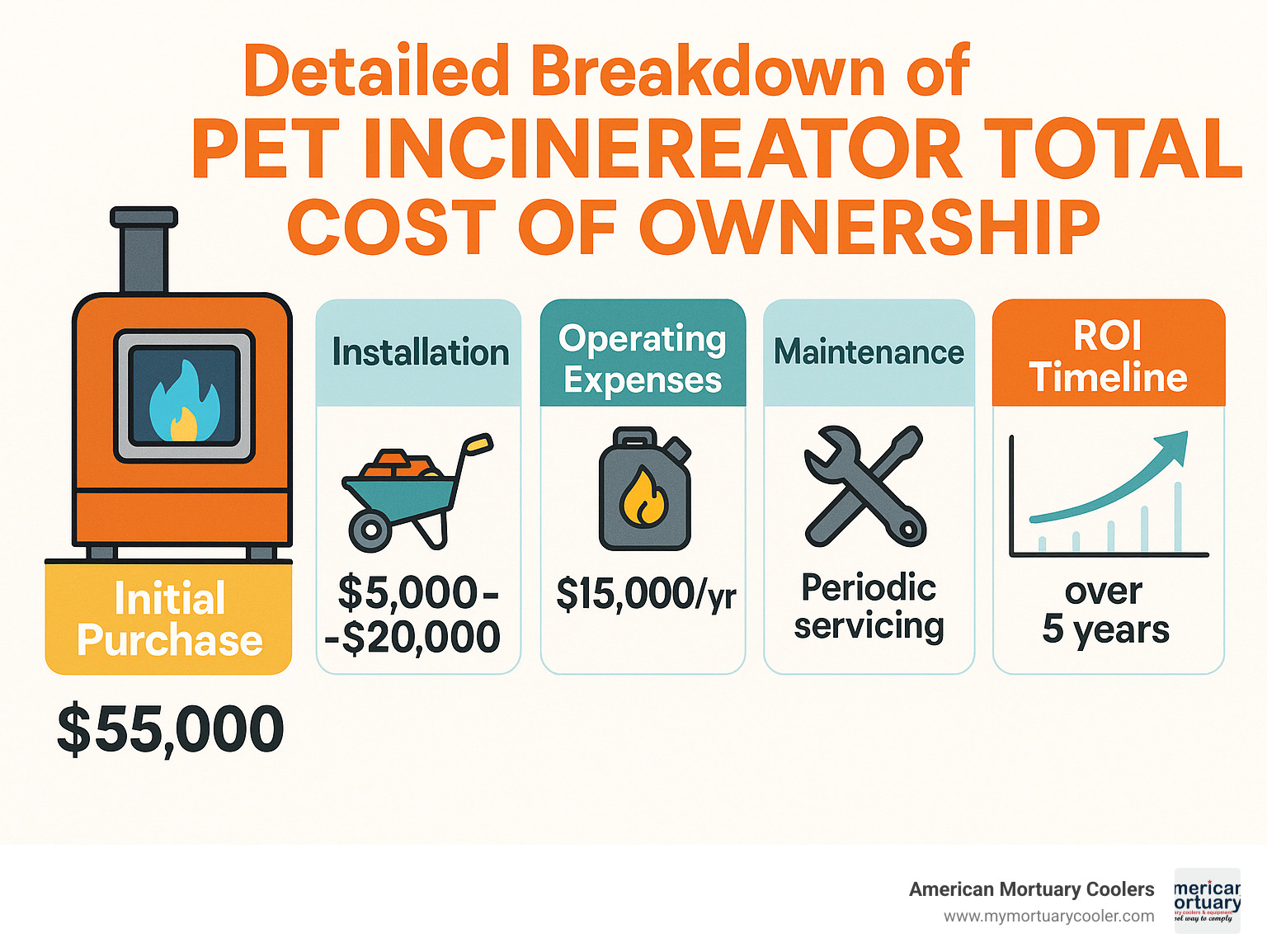
Pet incinerator cost terms explained:
- Pet cremation equipment
- used pet cremation equipment for sale
How Does a Pet Incinerator Work?
Ever wondered what happens behind the scenes at a pet crematorium? Pet incinerators—also called cremators—are fascinating pieces of engineering designed with one important purpose: to help our beloved animals make their final transition with dignity (see the broader industrial process of incineration for additional context).
At heart, these systems use carefully controlled high-temperature combustion to reduce animal remains to ash. Modern units typically operate between a toasty 800-1200°C (1400-2200°F), hot enough to complete the process within a few hours.
As one of our industry colleagues likes to joke, "The main difference between an incinerator and a cremator is the spelling!" In practice, the terms are interchangeable, though many pet memorial services prefer "cremator" when speaking with grieving pet parents.
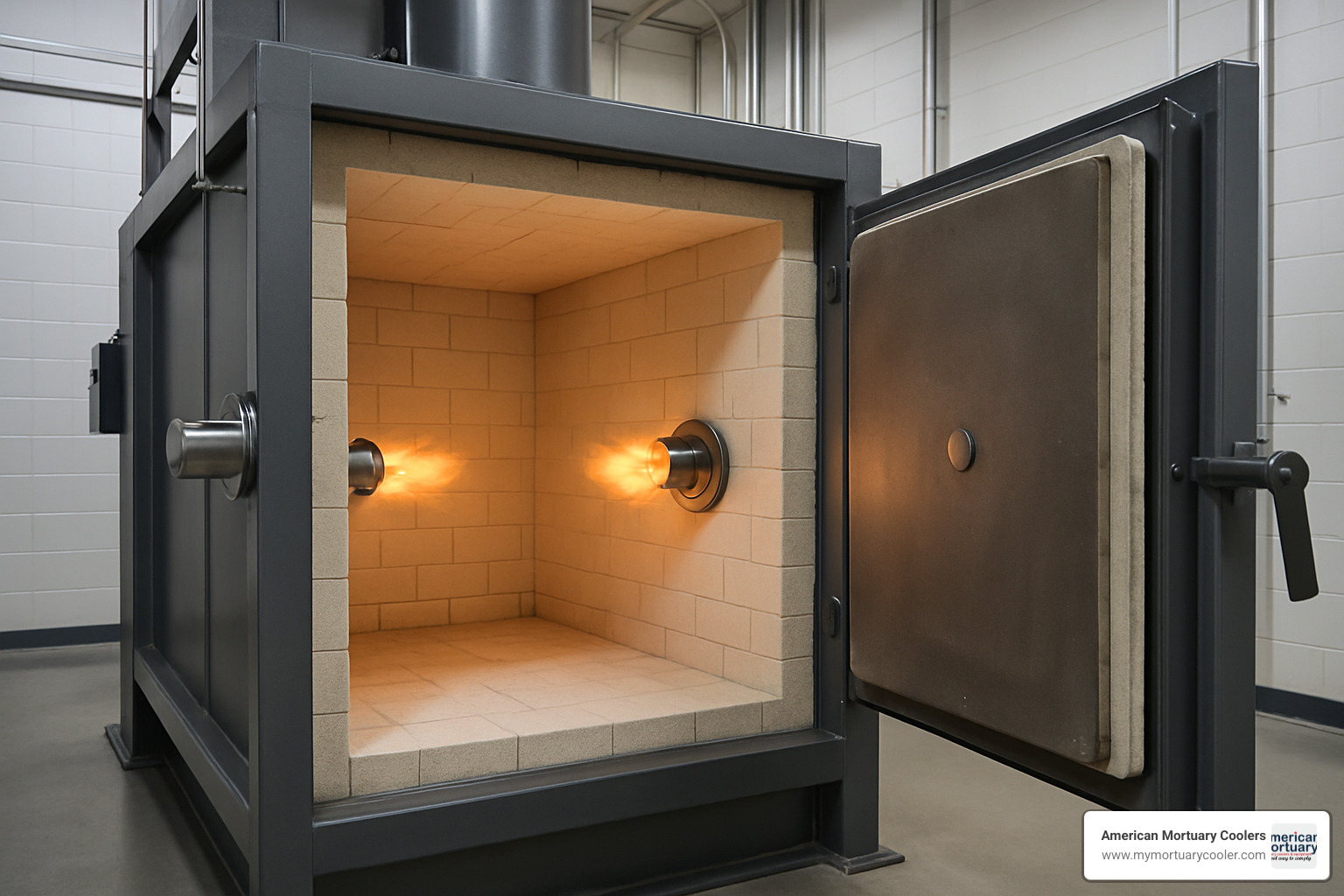
Key Components & Process Flow
Quality pet incinerators aren't just metal boxes with burners—they're sophisticated systems with several critical components working in harmony:
The journey begins in the primary chamber, where the animal remains are placed. Premium models feature "hot hearth" technology that surrounds remains with 360° heat for more efficient cremation at temperatures of 800-900°C. This design ensures complete and respectful processing while maximizing fuel efficiency.
Gases produced during cremation flow upward into the secondary chamber (or after-burner), which is the environmental hero of the system. Here, temperatures soar even higher—typically 1000-1200°C—burning away smoke, odors, and potentially harmful emissions before they can escape into the atmosphere.
The unsung hero of any quality incinerator is its refractory lining. These specialized walls (up to 10mm thick in premium models) are made from fire brick and specialized cement that can withstand extreme temperatures while providing excellent heat retention. This seemingly simple feature dramatically impacts your pet incinerator cost over time by improving fuel efficiency and reducing maintenance needs.
Throughout the process, thermocouples (temperature sensors) constantly monitor conditions inside both chambers, ensuring optimal operation. The brain of the system is its control system—modern units feature PLCs (Programmable Logic Controllers) that automate the entire cremation cycle, optimize fuel use, and keep detailed records for regulatory compliance.
The entire process typically takes 3-5 hours for average-sized pets, though this varies based on the animal's weight and your equipment's capacity. When choosing equipment, look for DEFRA (Department for Environment, Food and Rural Affairs) approval and compliance with regulations like EU Animal By-Products Regulation (EC) No 1069/2009. These certifications aren't just bureaucratic hoops—they're important quality markers that ensure your equipment meets stringent environmental and operational standards.
Understanding how these systems work isn't just technical trivia—it's essential knowledge that helps you evaluate the true operating costs and requirements before making such a significant investment for your business.
Types and Sizes of Pet Incinerators
Shopping for pet cremation equipment can feel overwhelming with so many options available. Let's break down the different types and sizes to help you understand what might work best for your business—and what that means for your pet incinerator cost.
Batch Units vs. Continuous Operation
Think of batch units as the solo performers of the cremation world. These single-chamber systems handle one cremation at a time, making them perfect for smaller operations just getting started. With prices beginning around $21,700 for models like the PET-200, they're the most budget-friendly entry point into the industry.
On the other hand, modular multi-chamber systems are like well-coordinated teams. These sophisticated units feature multiple independent chambers that share a common secondary chamber and chimney stack. The beauty of this design? You can start a new cremation while others are already in progress—a real game-changer for busy facilities. The A50-IC series exemplifies this approach, with starting prices around $55,000.
"Many of our clients who started with single chambers wished they'd invested in multi-chamber systems right from the beginning," I often tell people. "The efficiency gains usually pay for themselves faster than expected."
Loading Configurations
Most modern pet incinerators, including the popular PET-200 and A50-IC series, feature front-loading designs. These are ergonomically friendly, loading at waist height to spare your staff's backs during daily operations. It's a seemingly small detail that makes a huge difference in day-to-day comfort.
Top-loading systems still have their place, particularly when your facility layout has specific constraints or when space comes at a premium. They're less common but worth considering if your situation demands creative space solutions.

Specialized Models
For those serving larger animals, equine cremators represent a significant but necessary investment. These specialized systems accommodate horses and other large animals, with prices typically starting around $200,000 due to their substantial size requirements.
Mobile or containerized units offer flexibility that brick-and-mortar operations can't match. These pre-assembled, self-contained systems can be transported between locations—perfect for businesses serving multiple communities or remote areas. Companies like Nanjing Clover offer these units packed into 20ft export containers, ready to deploy wherever needed.
Capacity Ranges: From 1 to 60 Pets per Day
When it comes to pet incinerator cost, daily throughput capacity is perhaps the most influential factor. Here's what you can expect at different capacity levels:
For small operations handling 1-7 pets daily, models like the PET-200 or BLP 100/200 series (handling maximum loads of 100-200 lbs) are ideal. These units work perfectly for rural veterinary clinics or small memorial businesses, with costs ranging from $21,700-$30,000.
Medium-capacity operations processing 15-30 pets daily might consider the A50-IC(1) or A50-IC(2) models, or perhaps the BLP 500/750 series handling 500-750 lb loads. These systems serve busy veterinary hospitals or dedicated pet crematoriums in medium-sized markets well, with pet incinerator costs between $55,000-$100,000.
High-volume businesses managing 30-60+ pets daily need serious equipment like the A50-IC(4) or BLP 1000/2000 series. The BLP 1000 M10 even allows up to 10 private cremations in a single cycle—perfect for commercial cremation services or facilities serving multiple locations. These premium systems typically run $170,000-$220,000 or more.
I always advise clients to think about their three-year growth plan, not just current needs. Many businesses find they quickly outgrow smaller units as word spreads about their compassionate services. Investing in slightly more capacity than you currently need often proves wise in the long run, saving you from costly upgrades just a year or two down the road.
Pet Incinerator Cost Breakdown
Understanding the complete financial picture of pet incinerator acquisition and operation is essential for making an informed investment decision. Let's break down the various cost components that contribute to the total pet incinerator cost.
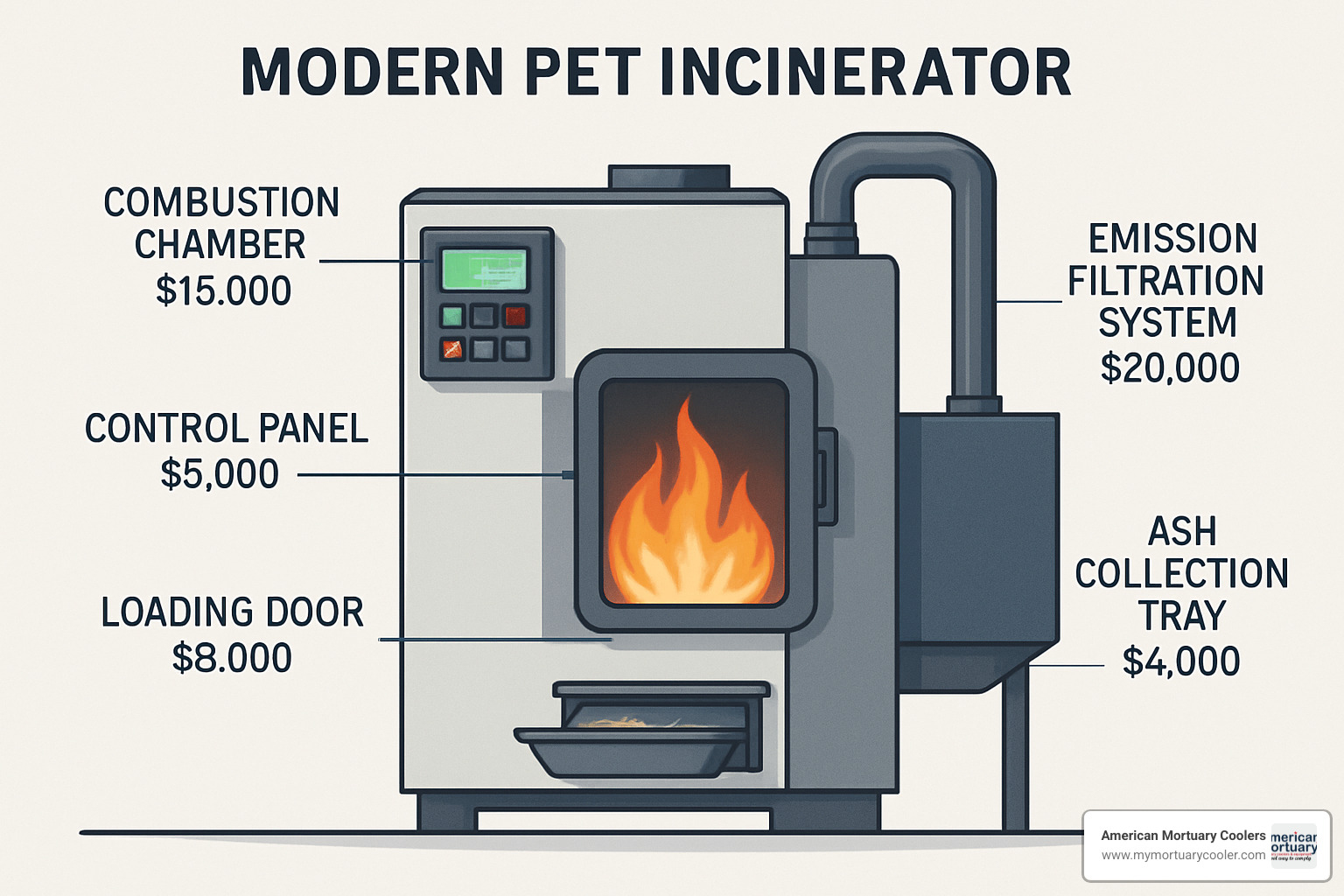
Purchase Price Ranges & Major Cost Drivers
The base purchase price of pet incinerators varies widely depending on several key factors:
When you're looking at the price tag of a new pet cremator, size and capacity lead the charge in determining what you'll pay. Small units handling just 1-7 pets daily start around $21,700 – perfect for a rural vet clinic just starting out. On the other end of the spectrum, those large commercial systems processing 60+ pets daily can set you back $220,000 or more.
Build quality makes a tremendous difference not just in longevity but in your operational costs. As one manufacturer likes to point out, "Addfield cremators are independently proven to save 40% on fuel compared with other manufacturers, increasing profitability." Those thicker refractory linings and superior steel construction might cost more upfront, but they're like buying good boots instead of cheap ones – you pay once and cry once.
The technology inside matters too. Modern PLC controls, data logging systems, and multi-chamber designs add to your initial pet incinerator cost, but they're investments that pay off through improved efficiency and throughput. Think of it as the difference between a flip phone and a smartphone – both make calls, but one does so much more.
Your choice of fuel type – natural gas, propane, or diesel – affects both purchase price and long-term operating costs. Dual-fuel capabilities cost more initially but provide flexibility that might save you if propane prices spike or natural gas becomes unavailable.
Brand reputation carries weight in this industry. Established manufacturers with proven track records and robust support networks typically charge more than newcomers, particularly those from emerging markets. It's like comparing a name-brand appliance to a generic – sometimes the peace of mind is worth the premium.
Don't forget shipping costs! For large units, freight can add thousands to your pet incinerator cost, especially if you're in a remote location or ordering internationally.
Installation & Setup Costs
The sticker price is just the beginning – installation represents a significant additional expense that catches many buyers off guard:
Delivery costs range from $1,000 for a small unit in an accessible location to $5,000 or more for remote destinations. If your new cremator weighs as much as a small car, you'll need a crane to position it, adding another $2,000-$10,000 to your budget.
The utility connections aren't DIY projects either. Professional contractors typically charge $5,000-$15,000 to handle gas and electrical hookups safely and to code. Site preparation – including pouring a concrete pad, making structural modifications, and installing proper ventilation – can run another $5,000-$25,000 depending on your facility's current setup.
Local regulations won't be ignored either. Permits and zoning fees can add $5,000-$15,000 to your project, varying widely by location. As one seasoned industry professional shared in an online forum: "Be prepared to spend around $300k-$500k for machine, delivery, setup, gas and electrical contractors, crane operator, EPA permit, zoning fees." While that estimate covers full-scale human cremation systems, even smaller pet units require significant installation investment.
Some manufacturers do offer "DIY" or local installation options that can trim these costs. Firelake Manufacturing, for example, estimates DIY/local installation at around $3,000 for their small A-series pet cremator – a substantial savings if you're handy or have reliable local contractors.
Ongoing Operating Costs
The true pet incinerator cost extends well beyond purchase and installation into day-to-day operations:
Fuel consumption forms the biggest ongoing expense, averaging $20-$40 per cremation cycle. This varies based on your unit's efficiency, local fuel prices, the size of each load, and your operating temperature. More efficient units with better insulation and refractory materials can save thousands annually in fuel costs.
Electricity adds another $5-$10 per cremation to run controls, blowers, and auxiliary systems. Annual maintenance parts – including refractory repairs, burner maintenance, and door seals – typically run $1,000-$5,000 depending on usage and equipment quality.
Labor costs add up too. Operator time typically runs 1-2 hours per cremation cycle at $25-$45 per hour, depending on your location and staffing structure. Many facilities also invest in annual service contracts ranging from $2,000-$10,000 for preventive maintenance and technical support.
For a medium-sized operation, these operating costs typically average around $58 per cremation. If you're performing two cremations daily, that's approximately $45,360 annually just to keep things running.
ROI, Payback & Financing Options
Despite the substantial investment, pet incinerators can deliver impressive returns when properly managed:
For a small A-series unit costing $24,700 total ($21,700 purchase + $3,000 installation), the numbers look promising. With just one cremation per day at an average price of $180, you're looking at annual sales of $47,520. After deducting operating costs of about $21,648, you're left with a healthy annual net profit around $20,332. At that rate, you'll recoup your investment in approximately 1.2 years.
Medium-sized units ($55,000) handling two cremations daily can generate annual sales of $90,720. After operating costs of $45,360, your annual net profit lands around $32,760, paying back your investment in about 1.7 years.
Full-scale commercial units, despite their hefty $220,000 price tag, can process eight cremations daily for annual sales of $445,680. Even with substantial operating costs of $222,840, you're looking at annual profits around $176,840 – recouping your investment in just 1.2 years.
Financing options can make these investments more accessible. Equipment leasing typically offers 3-7 year terms with monthly payments and potential tax advantages. Bank loans, often secured by the equipment itself, typically run 5-10 years. Some manufacturers like Inciner8 offer direct financing options. Small businesses might qualify for favorable SBA loans as well.
As one industry expert succinctly put it, "Every time the cremator is used, it makes money." In fact, many businesses find that delaying the purchase of a pet incinerator actually costs them more in lost revenue than the expense of acquiring one. At American Mortuary Coolers, we've seen this pattern repeatedly – making the right investment at the right time can transform both your service offerings and your bottom line.
Incineration vs. Other Pet Disposition Methods: Cost & Sustainability
When considering the pet incinerator cost for your business, it's worth taking a step back to see how cremation compares to other options available to pet owners. After all, understanding the full landscape helps you make a more informed investment decision.
Comparative Cost Table & Environmental Impact
| Method | Provider Cost | Consumer Price | Environmental Considerations |
|---|---|---|---|
| Private Cremation | $58-100/animal | $150-350 | Emissions from fuel consumption, but modern after-burners minimize impact |
| Communal Cremation | $30-50/animal | $30-70 | More efficient fuel use per animal, but same emission concerns |
| Aquamation | Equipment: $210K-330K Operating: $25-35/animal |
$150-400 | Lower carbon footprint, but uses significant water and alkali chemicals |
| Burial (Pet Cemetery) | Land costs, maintenance | $500-1,500+ initial, plus annual fees |
Land use concerns, potential groundwater issues from non-biodegradable caskets |
| Home Burial | N/A | Free (where legal) | Minimal if done properly, but potential health concerns |
I've spoken with many pet service providers who've explored various options before settling on cremation. While aquamation (alkaline hydrolysis) has been gaining attention for its environmental benefits, the reality is that the equipment investment is substantial – basic models start at $209,900, with premium units reaching $329,900.
One funeral director shared with me: "I've sat down with over 2,500 families in 10 years and never once was asked about aquamation." This highlights an important consideration – despite growing environmental awareness, consumer demand doesn't always align with the newest technologies.
From a business perspective, traditional cremation offers a more accessible entry point with pet incinerator costs starting much lower than aquamation equipment. The operational costs are comparable, with cremation running $58-100 per animal and aquamation at $25-35 per animal.
For pet owners considering burial options, the expenses can add up quickly. Pet cemeteries typically charge $500-1,500 for initial interment, plus ongoing annual fees for plot maintenance. While home burial is essentially free where legally permitted, it comes with limitations – apartment dwellers and those with small properties often don't have this option, and some municipalities restrict pet burial entirely.
From a sustainability standpoint, modern pet cremation technology has come a long way. Today's incinerators with properly designed secondary chambers and emission controls produce significantly fewer pollutants than older models. The environmental debate between cremation's air emissions versus aquamation's water usage and chemical disposal continues, with valid points on both sides.
When you're calculating the true pet incinerator cost for your business model, consumer preferences and local regulations will heavily influence which services you should offer. At American Mortuary Coolers, we've found that most of our customers achieve the best balance of profitability and environmental responsibility with modern, efficient cremation equipment that meets or exceeds current emission standards.
Regulations, Permits & Environmental Compliance
Let's face it—nobody gets excited about paperwork and permits. But understanding the regulatory landscape is essential when calculating your true pet incinerator cost. These requirements aren't just bureaucratic hoops; they protect our environment and communities.
"The first question I ask potential crematory owners isn't about budget—it's about whether they've checked local zoning laws," shares one of our equipment specialists at American Mortuary Coolers. "You'd be surprised how many folks put down deposits before confirming they can legally operate."
Meeting Local & Federal Standards
The regulatory framework varies dramatically depending on your location, but typically includes several key elements:
Air Quality Permits form the backbone of cremation regulation. In the United States, you'll need EPA approval through Form 8700-12 (the RCRA Subtitle C Site Identification Form). Our friends across the pond face DEFRA certification requirements, while European operators must comply with EU Animal By-Products Regulation (EC) No 1069/2009. These permits aren't just formalities—they ensure your operation won't harm the surrounding environment.
Zoning Approvals often prove to be the trickiest hurdle. Local zoning boards must approve your operation, which may require special use permits or variances. We've seen clients sail through this process in rural areas, while others in mixed-use or commercial zones faced months of community meetings and design modifications.

Stack Testing is where the rubber meets the road for emissions compliance. These tests verify your equipment meets air quality standards and typically cost between $3,000-$10,000 per test. Budget for these not just initially, but as ongoing expenses—most jurisdictions require periodic retesting.
Record-Keeping Requirements might seem mundane, but they're crucial for demonstrating compliance. You'll need detailed logs of all cremations, maintenance activities, and emissions tests. Modern equipment often includes digital logging systems that simplify this process considerably.
Operator Certification requirements are growing increasingly common. Some jurisdictions now require formal training and certification for crematory operators—an additional expense to factor into your staffing budget.
All told, these regulatory requirements typically add $5,000-$15,000 to your initial pet incinerator cost, plus ongoing expenses for testing and renewals. It's not chump change, but consider it an investment in operational security and community goodwill.
The technical specifications of your equipment play a major role in meeting these standards. When evaluating different models, pay close attention to:
- Secondary chambers with minimum 2-second residence time at 1000-1200°C
- Combustion efficiency ratings (look for at least 99.0%)
- Vertical exhaust stacks with minimum exit velocity of 10 m/s
- Temperature and emissions monitoring systems
At American Mortuary Coolers, we've guided countless clients through this regulatory maze. While we can't make the paperwork disappear, we can help you understand which equipment features will simplify compliance in your specific location. Because the only surprise you want with your new pet cremation business is how quickly it becomes profitable—not an unexpected visit from environmental regulators!
What Pet Owners Actually Pay for Cremation Services
Understanding what pet owners actually pay for cremation services helps put your investment in perspective. These consumer prices directly impact your revenue projections and how quickly you'll recover your pet incinerator cost.
Based on our industry research at American Mortuary Coolers, here's what pet owners typically pay across the country:
Small animals like birds, rabbits, and ferrets generally cost between $55-$100 for cremation services. Cat owners and those with small dogs under 50 pounds typically pay $100-$150, while medium to large dogs (50-120+ pounds) command higher prices ranging from $150-$350.
These price variations aren't arbitrary. They reflect meaningful differences in service quality and approach. Private cremation ensures your client's pet is cremated individually, with only their pet's ashes returned. This premium service typically costs 2-3 times more than communal options, but many grieving pet owners find the peace of mind well worth it.
Communal cremation represents the budget-friendly alternative at $30-$70, where multiple animals are cremated together with no ashes returned. For those seeking middle ground, semi-private cremation places multiple pets in the same chamber but separated by dividers, priced between private and communal rates.
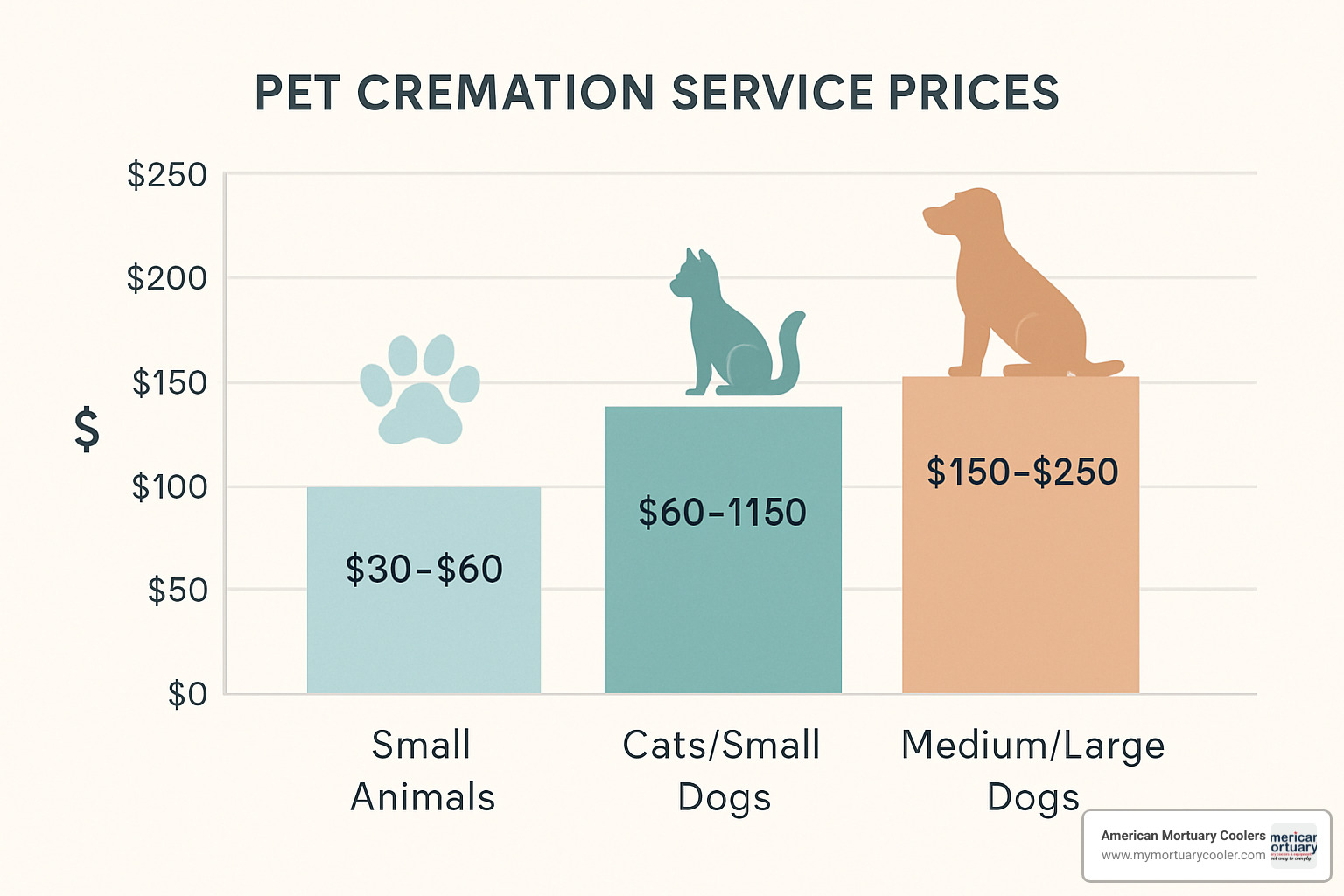
Where your business is located matters too. Urban markets typically command 20-40% higher prices than rural areas. Dedicated pet crematoriums often charge premium rates compared to veterinary clinics offering cremation as an ancillary service.
Add-On Services That Raise the Bill
The base cremation fee is just the starting point of what pet owners actually pay. The emotional nature of pet loss creates opportunities for thoughtful add-on services that not only provide comfort but also increase your revenue per client.
Transportation services are practically essential, with pick-up fees ranging from $45-$75 (and even higher for after-hours service). Many facilities now offer viewing options for $25-$100, allowing owners to witness the cremation process—something that was rare a decade ago but is increasingly requested.
The selection of memorial products represents a significant revenue opportunity. Basic urns typically sell for $50-$150, while premium artistic urns can command $150-$1,000 or more. Simple engraved nameplates add $10-$25 to the bill, and memorial jewelry containing a small portion of ashes has become increasingly popular at $50-$300.
"Many pet owners are surprised by how meaningful it is to have a physical keepsake," shares one of our veterinary clients. "Something as simple as a $15 paw print or fur clipping becomes their most treasured memento."
Some facilities have expanded into full memorial services ($100-$500) and home delivery of remains ($25-$100 depending on distance). Others incorporate bereavement support through counseling services or support groups, which creates tremendous goodwill even when offered complimentary.
These thoughtful additions can double or triple your basic cremation fee while providing genuine emotional support to grieving pet owners. They represent important revenue streams that can dramatically accelerate your return on investment in pet cremation equipment.
As we've seen at American Mortuary Coolers, pet cremation continues to grow in popularity because it offers an affordable option that allows owners to keep their pet's remains or scatter them in a meaningful location. This emotional connection drives willingness to pay for quality service—particularly for private cremations where owners receive their pet's ashes.
More info about cremation options
Choosing a Supplier & Next Steps
Finding the right manufacturer for your pet cremation equipment is perhaps the most crucial decision you'll make—one that goes far beyond just the initial pet incinerator cost. Think of it as choosing a long-term business partner who'll support you for the next 10-15 years.
Warranty and Support
A cremator sitting idle means lost revenue and disappointed clients—not a situation any of us want to face. That's why warranty and support should be top priorities when evaluating suppliers.
The best manufacturers offer comprehensive warranties ranging from 1-3 years, but what's written on paper is only part of the equation. What really matters is how they respond when something goes wrong. Before signing on the dotted line, have a candid conversation about their support network:
"Do you have technicians in my region who can be on-site within 24 hours?" is a question worth asking. Remote areas might face longer wait times, which could mean days of downtime.
Phone support availability is equally important—cremation equipment doesn't only break down during business hours! Some manufacturers offer 24/7 technical assistance that can talk you through minor issues, potentially saving you the cost and wait time of an in-person service call.
Parts Availability and Longevity
I once spoke with a frustrated vet who had purchased an imported incinerator only to find replacement parts took 8-12 weeks to arrive from overseas. His equipment sat unused for nearly three months while he continued paying on his lease. Don't let this happen to you!
Quality manufacturers maintain robust parts inventories and typically support their equipment for 15+ years—the average lifespan of a pet incinerator. Before purchasing, ask pointed questions about their parts program:
"If my primary burner fails, how quickly can I get a replacement?" The answer should be days, not weeks or months.
Also inquire whether they use proprietary components or standard parts available from multiple sources. The latter gives you options if the original manufacturer goes out of business or experiences supply chain issues.
Manufacturing Quality and Inspection
"Visit the factory to see craftsmen build the machines," as one manufacturer wisely suggests. Nothing reveals more about build quality than seeing the construction process firsthand.
If a factory visit isn't practical, ask for detailed photos or videos of their manufacturing facility. Look for signs of quality craftsmanship like thick refractory materials (8-10mm minimum is the industry standard), robust steel construction, and meticulous welding.
Certifications matter too. Reputable manufacturers proudly display their DEFRA approvals, EU compliance certificates, and other relevant credentials. These aren't just fancy pieces of paper—they're evidence that the equipment meets stringent environmental and safety standards.
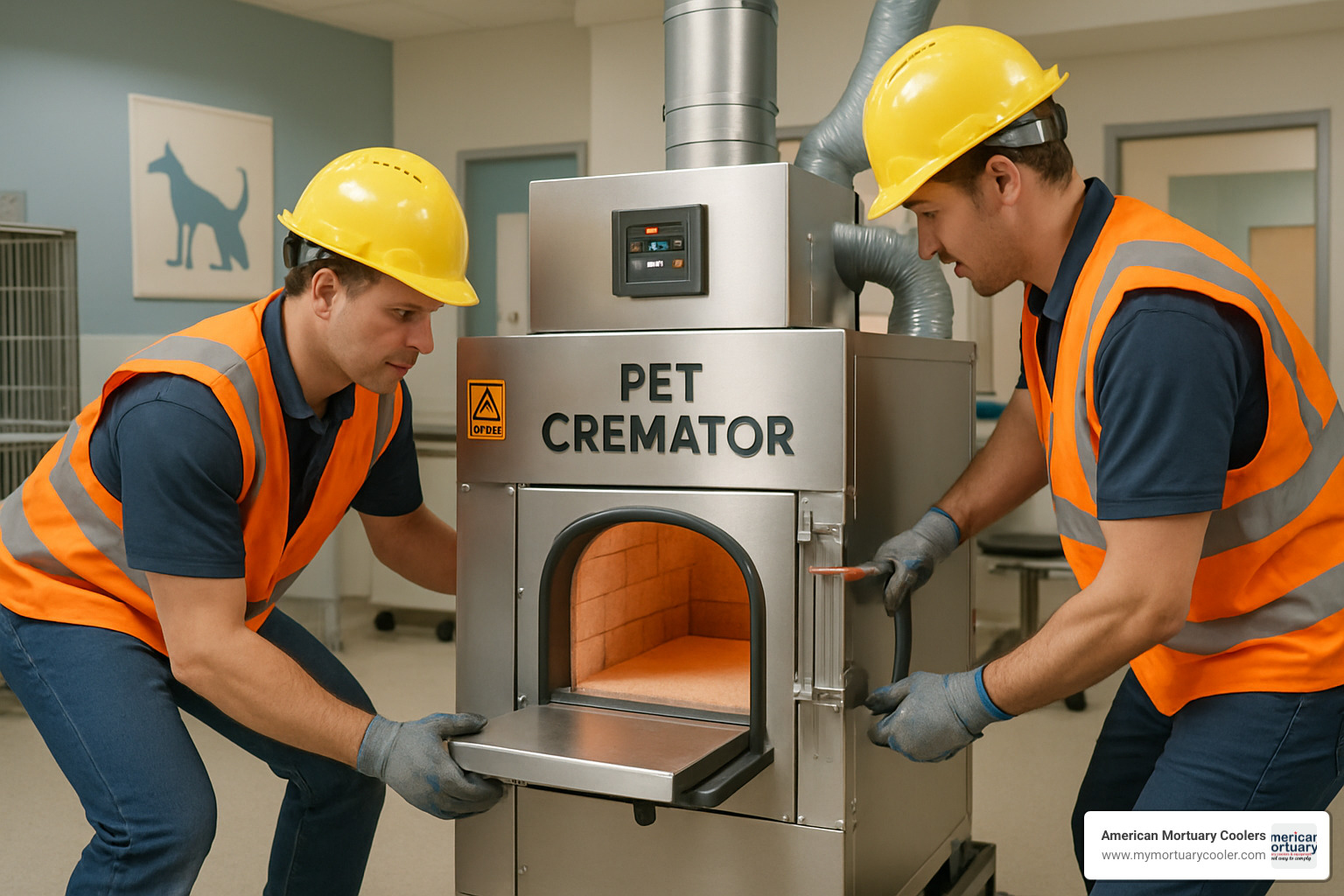
References and Track Record
There's nothing quite like hearing from people who've already walked the path you're considering. Good manufacturers will happily connect you with existing customers who can speak to their experience.
When checking references, go beyond surface-level questions. Ask about the nitty-gritty details:
"How responsive is the company when something breaks down?"
"Have you encountered any recurring issues with the equipment?"
"If you could go back in time, would you still choose this manufacturer?"
These conversations often reveal insights no brochure or sales presentation will mention.
Red Flags & Must-Ask Questions
After helping dozens of veterinary clinics and pet memorial businesses select equipment, we've learned to spot warning signs that suggest potential problems down the road.
Unrealistic fuel efficiency claims should make you raise an eyebrow. Yes, some manufacturers legitimately achieve up to 40% better efficiency than competitors, but claims beyond this benchmark deserve scrutiny. Ask for data to back up these assertions.
Missing compliance documentation is another red flag. If a supplier hesitates or gives vague answers when asked for environmental certificates, proceed with caution—or better yet, look elsewhere.
If you're starting small but anticipate growth, ensure the manufacturer offers a clear expansion path. Can chambers be added later? Can the system be upgraded without replacing everything? The answers will impact your long-term pet incinerator cost.
The financing fine print deserves careful attention too. Some lease agreements include balloon payments or punitive early termination fees that can catch you off guard. Take time to understand what you're signing.
At American Mortuary Coolers, we've built our Tennessee-based business on understanding the unique needs of death care professionals. We partner only with manufacturers who meet our stringent quality standards and can provide the ongoing support our customers deserve. Our team across the United States can help guide you through these considerations to find the perfect solution for your specific needs and budget—without the headaches that come from choosing the wrong supplier.
Frequently Asked Questions about Pet Incinerator Costs
How much space and utility capacity will I need?
When planning for your pet cremation equipment, the physical space requirements depend largely on the capacity you choose. Small units handling 1-7 pets daily typically need about 4' x 6' of floor space, plus recommended clearances for safety and maintenance access. If you're considering a medium-sized system for 15-30 pets daily, you'll need to allocate 6' x 8' up to 8' x 10' plus those important clearances. For those planning high-volume operations, large commercial units processing 60+ pets daily require at least 10' x 12' or larger, again with appropriate clearances.
Beyond just floor space, you'll need to ensure your facility can support the necessary utilities:
Your electrical system should accommodate 220V/30-50A service to power the control systems and blowers. Gas requirements typically include a 1" natural gas line or a 500-1000 gallon propane tank, depending on your preferred fuel type. Don't forget about ventilation—you'll need a 12-24" diameter stack that extends above your roofline to properly vent emissions. While water isn't strictly required for operation, having a nearby source is definitely recommended for cleaning procedures.
As one of our clients mentioned after installation, "I wish someone had told me to add an extra foot of clearance on all sides—it makes maintenance so much easier!"
Can I start small and add chambers later?
Absolutely! This approach has saved many of our clients significant money as they grow. Modular systems like the Addfield range are specifically designed for expansion, allowing you to add primary chambers to an existing host machine as your business develops.
The beauty of this design is that you can reuse the secondary chamber, control systems, and chimney stack while adding more primary chamber capacity. As Addfield's literature explains: "Add additional chambers, reuse of after chamber, shared chimney stack."
From a pet incinerator cost perspective, this approach makes tremendous financial sense. Adding chambers typically costs just 40-60% of what you'd pay for a completely new standalone unit with equivalent capacity. For a growing business watching cash flow, this staged investment approach can be the difference between profitability and financial strain.
One of our veterinary clients in Colorado started with a single-chamber unit and added a second chamber just 18 months later as demand grew—they saved nearly $30,000 compared to buying a complete new system.
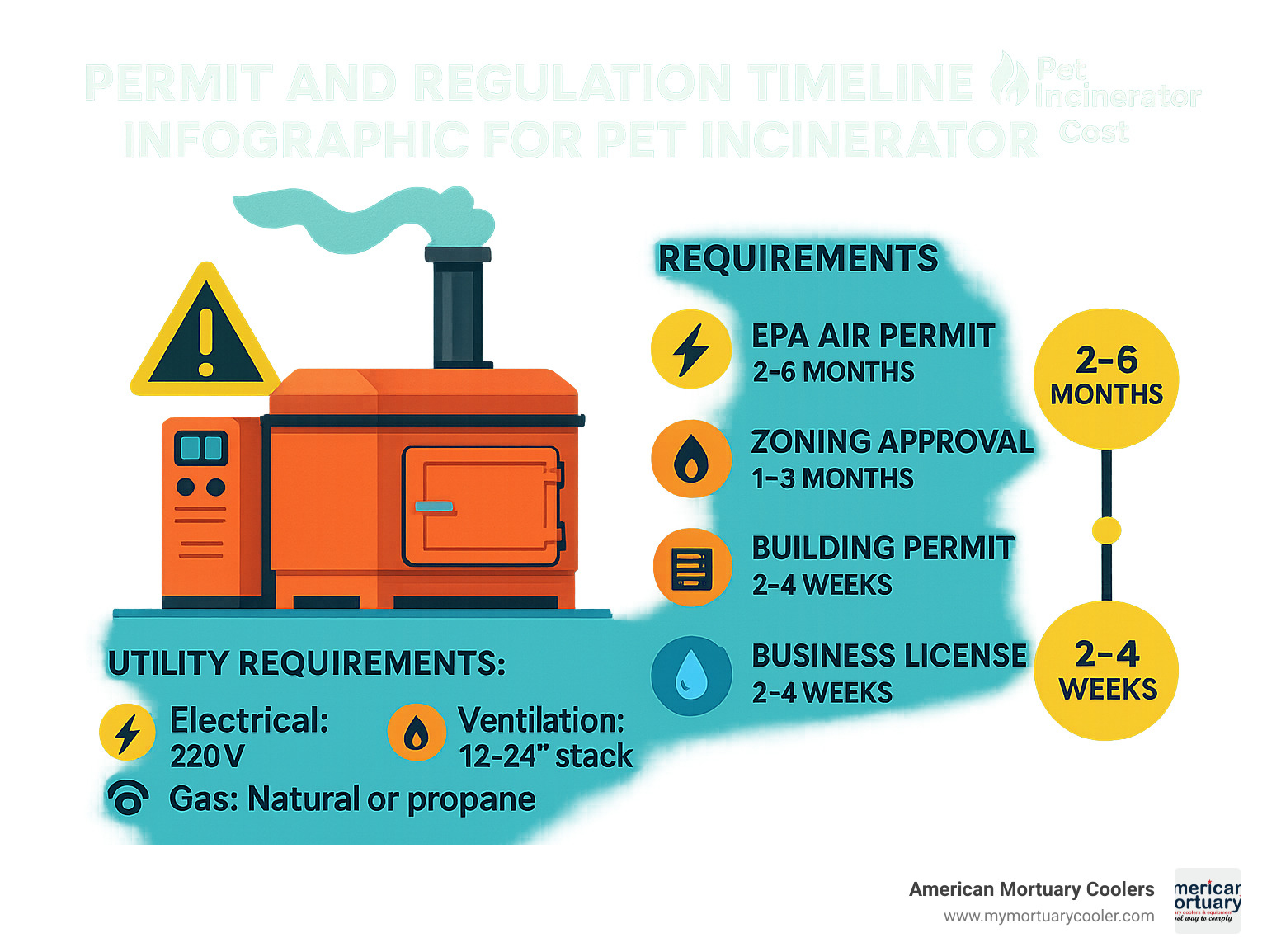
What permits should I budget time and money for?
The permitting process is often the most time-consuming (and occasionally frustrating) part of setting up a pet cremation business. It's important to budget both patience and funds for these requirements.
EPA Air Permits will cost you between $2,000-$5,000 and typically take 2-6 months to process. These regulate emissions and ensure your equipment meets environmental standards. Local Zoning Approval runs $500-$2,000 with a 1-3 month processing timeline—this confirms your business can legally operate in your chosen location.
Don't forget about Building Permits ($500-$2,000, 2-4 weeks) for any facility modifications needed to accommodate your equipment. Standard Business Licenses are relatively straightforward at $100-$500 with 2-4 weeks processing. Depending on your location, you may also need Waste Handling Permits costing $500-$2,000 with a 1-3 month wait.
All told, you should budget between $5,000-$15,000 for permits alone, and don't expect to be operational in less than 3-6 months from when you start the application process. Many of our clients find that working with consultants familiar with local requirements can streamline this process, though this obviously adds to your initial investment.
"The permits took twice as long as I expected," shared a pet crematory owner in Florida, "but having all the proper paperwork in place gives me peace of mind that we're operating legally and ethically."
At American Mortuary Coolers, we've guided numerous clients through this process and can help you steer the permitting maze specific to your location. Just give us a call—we're happy to share what we've learned from helping others through this journey.
Conclusion
When it comes to pet incinerator cost, there's so much more to consider than just the sticker price on the equipment. It's like buying a car—the purchase price is only the beginning of the story.
The good news? Pet cremation equipment can be one of the smartest investments you'll make for your business. Most of our clients see their equipment pay for itself within 1-2 years, and these sturdy machines typically serve faithfully for 15+ years. That's a lot of return on your initial investment!
I remember what one of our long-time customers told me last year: "Every time the cremator is used, it makes money." He started with a small unit seven years ago and has since upgraded twice as his business grew. What initially seemed like a daunting expense became the cornerstone of his thriving pet memorial service.
At American Mortuary Coolers, we understand this isn't just a business decision—it's about providing a meaningful service during a difficult time for pet owners. Our team across the country (with offices in the Southeast, Southwest, Midwest, Northeast, Rocky Mountain, and Pacific regions) is ready to help you:
- Figure out exactly what size and type of equipment matches your needs
- Compare options from manufacturers we trust (we've seen the good, the bad, and the ugly!)
- Break down the complete financial picture so there are no surprises
- Steer the maze of permits and compliance requirements (which can be a headache if you go it alone)
- Plan for a smooth installation and efficient operation
Whether you're a vet clinic looking to bring cremation services in-house or an entrepreneur starting a dedicated pet memorial business, we've walked this path with hundreds of clients before you.
Our team in Johnson City, Tennessee is just a phone call away, ready to answer your questions and help you find the perfect balance between your budget, your business goals, and the level of service you want to provide families saying goodbye to their beloved companions.
We've found that the most successful pet cremation businesses aren't necessarily the ones who bought the fanciest equipment—they're the ones who thoughtfully matched their equipment to their specific needs and community. Let us help you do the same.